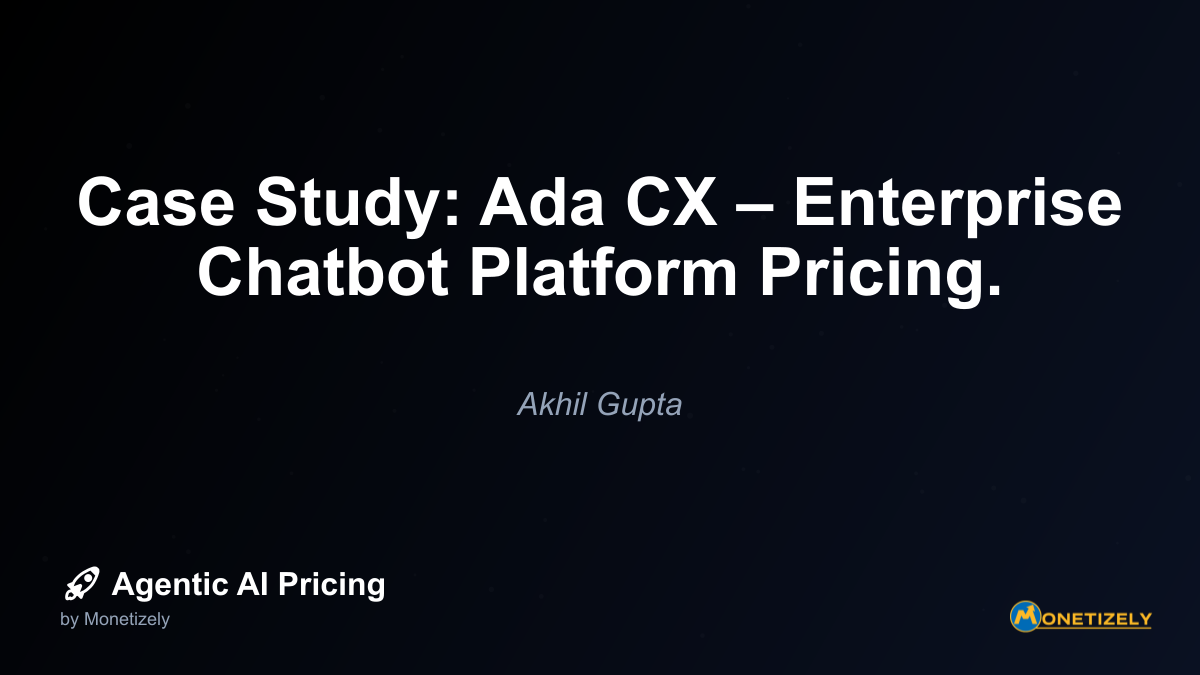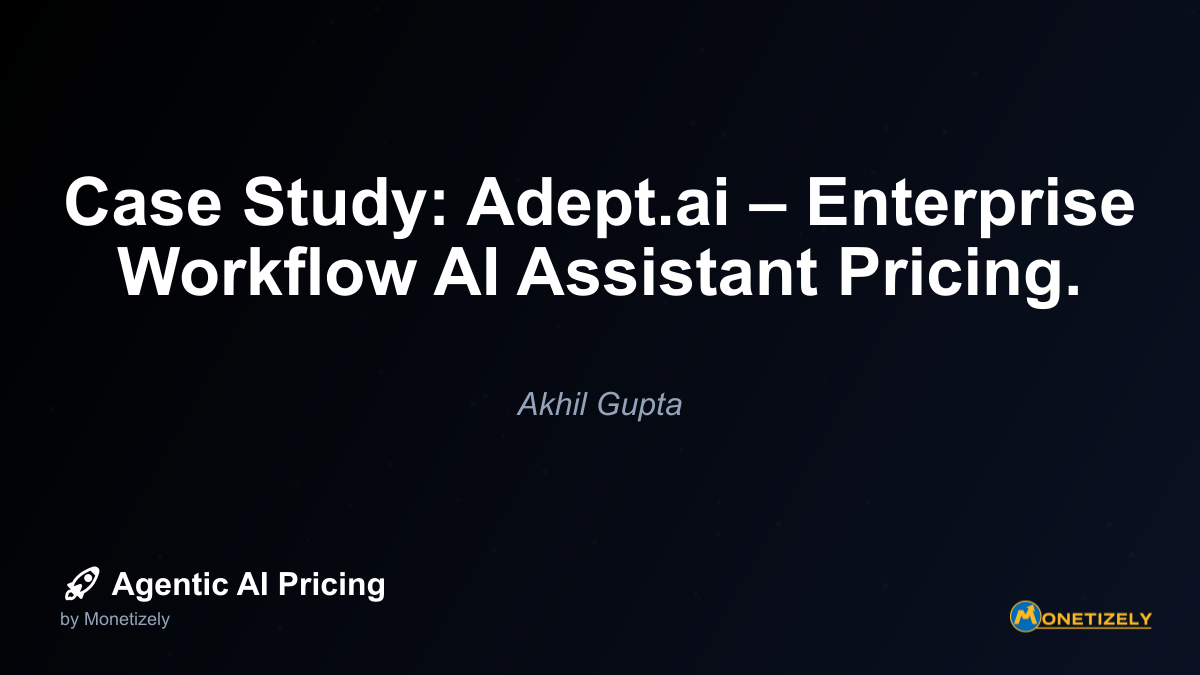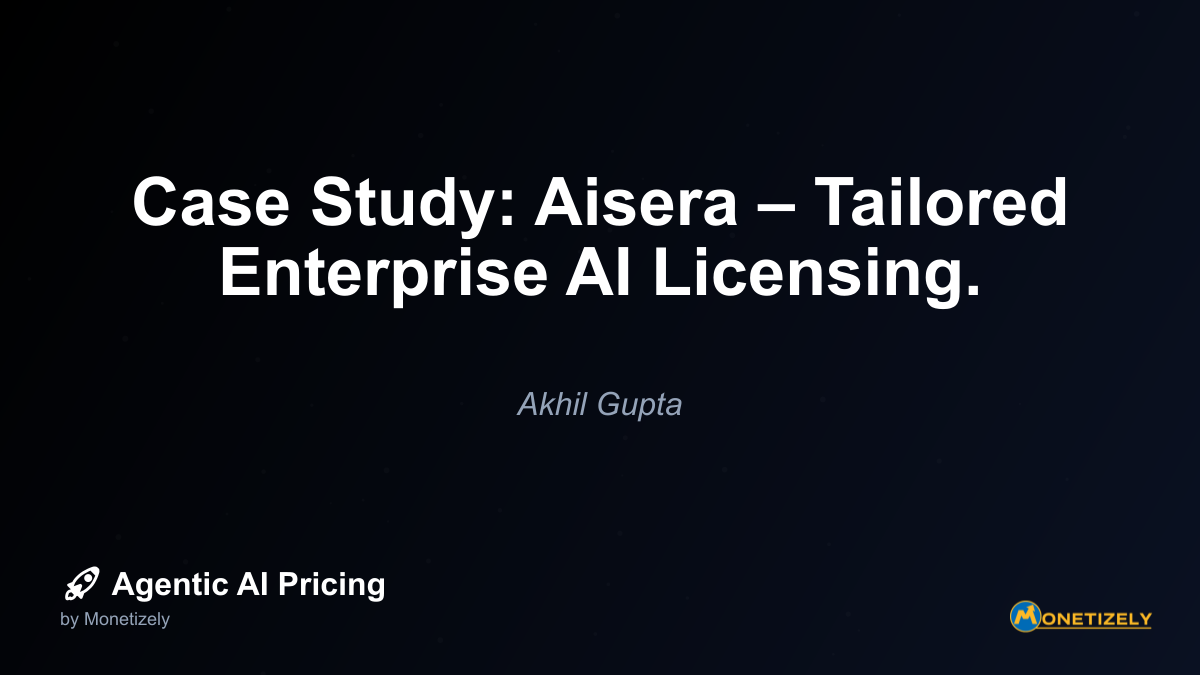· Akhil Gupta · Case Studies · 6 min read
Case Study: Ada CX – Enterprise Chatbot Platform Pricing.
AI and SaaS Pricing Masterclass
Learn the art of strategic pricing directly from industry experts. Our comprehensive course provides frameworks and methodologies for optimizing your pricing strategy in the evolving AI landscape. Earn a professional certification that can be imported directly to your LinkedIn profile.

Market Positioning Through Pricing
Ada’s pricing strategy serves as a critical element in its overall market positioning. By focusing exclusively on enterprise-level pricing with custom quotes, the company clearly signals its target market and differentiates itself from more accessible, but potentially less robust, chatbot solutions.
Enterprise-Only Focus
Unlike platforms that attempt to serve both small businesses and enterprises with tiered pricing, Ada has committed fully to the enterprise segment. This focus enables the company to:
- Develop features specifically for complex enterprise environments
- Provide the high-touch support and implementation assistance enterprises expect
- Avoid the product compromises that often result from trying to serve disparate market segments
Value Signaling
The absence of published pricing and the custom-quoted approach sends a clear signal about Ada’s premium market position. This strategy aligns with research showing that enterprise buyers often associate transparent, low pricing with reduced capability or limited support – even when this correlation isn’t necessarily accurate.
As noted in Monetizely’s analysis of AI pricing models, enterprise subscription models like Ada’s provide predictability that many large organizations prioritize over potential cost savings from usage-based alternatives.
Challenges and Limitations of Ada’s Pricing Approach
While Ada’s enterprise subscription model offers numerous advantages, it also presents certain challenges and limitations that are worth examining:
Sales Cycle Complexity
The custom-quoted approach naturally extends sales cycles as it requires detailed discovery, solution design, and negotiation phases. This complexity can increase customer acquisition costs and slow growth compared to more standardized pricing models.
Transparency Concerns
As B2B software buyers increasingly expect pricing transparency, Ada’s approach may create friction with procurement teams accustomed to comparing standardized pricing across vendors. This lack of transparency can occasionally position Ada at a disadvantage against competitors who publish clear pricing tiers.
Scaling Challenges for Mid-Market
The custom enterprise approach works well for large organizations but may create barriers for mid-sized companies that could benefit from Ada’s platform but lack the resources to engage in lengthy enterprise sales processes. This potentially leaves an opening for competitors to capture this segment with more accessible pricing models.
Perceived Risk for New Categories
For organizations new to conversational AI, the inability to quickly understand potential costs without engaging with sales representatives can increase perceived risk and implementation barriers. This is particularly relevant as chatbots transition from novel technology to essential customer service infrastructure.
Adaptation and Evolution of Ada’s Pricing
Like most successful enterprise SaaS providers, Ada has evolved its pricing approach over time to address market changes and customer feedback. Several notable adaptations include:
Value Metrics Refinement
Ada has reportedly refined its primary value metrics, moving from broader measures like total customer base to more nuanced calculations that better reflect platform utilization and value creation. This evolution demonstrates the company’s commitment to aligning pricing with customer-perceived value.
Packaging Simplification
Industry sources suggest Ada has worked to simplify its offering structure over time, reducing the complexity of proposals and making it easier for prospects to understand what they’re purchasing. This trend toward simplification reflects broader movements in enterprise software toward more transparent and comprehensible pricing models.
Strategic Discounting Approaches
Ada has developed sophisticated discounting strategies that incentivize behaviors beneficial to both parties, such as longer contract terms, expanded use cases, or participation in case studies. These approaches maximize customer lifetime value while providing clients with opportunities to optimize their investments.
Lessons for AI Pricing Strategists
Ada’s approach to pricing offers valuable insights for other AI solution providers, particularly those targeting enterprise markets:
1. Align Pricing with Value Creation
Ada’s focus on customer base size rather than interaction volume demonstrates the importance of identifying pricing metrics that align with the actual value customers receive. For customer service automation, this value derives primarily from the scale of customers served rather than the raw number of interactions.
2. Balance Predictability with Flexibility
The bounded unlimited usage model strikes an effective balance between giving customers predictable costs while maintaining pricing that scales with customer size and value received. This approach avoids the drawbacks of pure usage-based models while still ensuring fair value exchange.
3. Consider the Full Customer Journey
Ada’s pricing strategy accounts for the entire customer lifecycle, from initial implementation through expansion. By focusing on long-term relationships rather than maximizing initial deal size, the company builds sustainable revenue streams and customer loyalty.
4. Recognize Market Segment Differences
By fully committing to enterprise requirements rather than attempting to serve all market segments, Ada has created a pricing structure optimized for its target customers. This focus allows for appropriate investment in enterprise-specific features and support capabilities.
The Future of Enterprise AI Pricing: Trends to Watch
As the AI chatbot market continues to evolve, several emerging trends may influence how Ada and similar platforms approach pricing in the future:
Outcome-Based Pricing Components
Some enterprise AI providers are beginning to incorporate outcome-based elements into their pricing models, tying portions of costs to measurable business outcomes like reduced support costs or improved customer satisfaction scores. Ada may explore hybrid models that maintain subscription predictability while incorporating performance incentives.
Increased Transparency Pressure
As the market matures and procurement teams gain sophistication in evaluating AI solutions, pressure for greater pricing transparency will likely increase. Ada may need to balance its custom approach with more accessible information about pricing ranges or starting points.
Consumption-Based Hybrid Models
The broader enterprise software market is seeing increased adoption of consumption-based models that offer greater flexibility than traditional subscriptions. Ada might explore hybrid approaches that maintain predictable base subscriptions while incorporating consumption elements for certain premium features or extraordinary usage scenarios.
Vertical-Specific Packaging
As the chatbot market matures, industry-specific solutions with tailored pricing models are emerging. Ada may evolve toward more standardized packages for specific verticals like retail, financial services, or telecommunications, each with pricing structures optimized for industry-specific value drivers.
Conclusion: The Strategic Value of Ada’s Enterprise Pricing Approach
Ada CX’s enterprise subscription pricing strategy exemplifies a thoughtful approach to monetizing AI-powered customer service solutions at scale. By focusing on customer base size rather than transaction volume, providing unlimited usage within defined parameters, and employing a custom-quoted model, Ada has created a pricing structure that aligns well with enterprise buying expectations while supporting sustainable business growth.
The case demonstrates how AI solution providers can move beyond simplistic usage-based pricing toward more sophisticated models that better reflect the actual value delivered to customers. For enterprise buyers, Ada’s approach offers predictability and encourages comprehensive implementation, while for Ada itself, the model supports the high-touch sales and support approach that enterprise clients expect.
As the conversational AI market continues to mature, Ada’s pricing strategy will likely continue evolving to address changing market dynamics, competitive pressures, and customer expectations. The company’s success thus far suggests that enterprise subscription models with custom elements will remain a cornerstone of enterprise AI pricing, even as new hybrid approaches emerge to address specific market segments or use cases.
For business leaders evaluating AI chatbot solutions, understanding Ada’s pricing approach provides valuable context for navigating the often complex landscape of enterprise AI pricing and for evaluating the true cost and value proposition of conversational AI platforms.
Co-Founder & COO
Akhil is an Engineering leader with over 16+ years of experience in building, managing and scaling web-scale, high throughput enterprise applications and teams. He has worked with and led technology teams at FabAlley, BuildSupply and Healthians. He is a graduate from Delhi College of Engineering and UC Berkeley certified CTO.
Pricing Strategy Audit
Let our experts analyze your current pricing strategy and identify opportunities for improvement. Our data-driven assessment will help you unlock untapped revenue potential and optimize your AI pricing approach.




